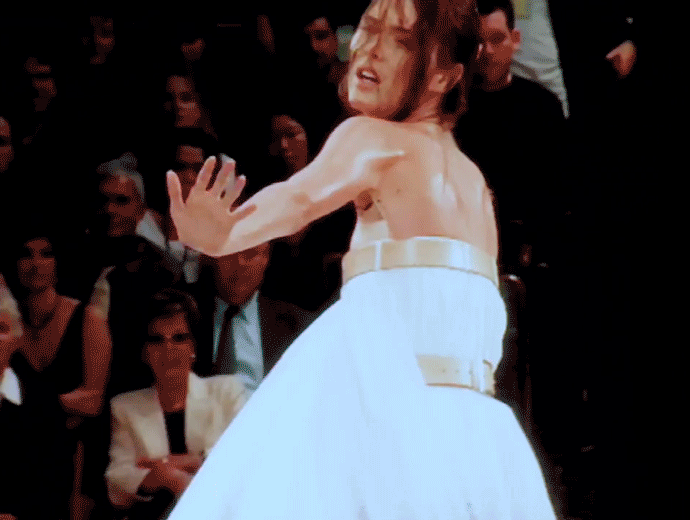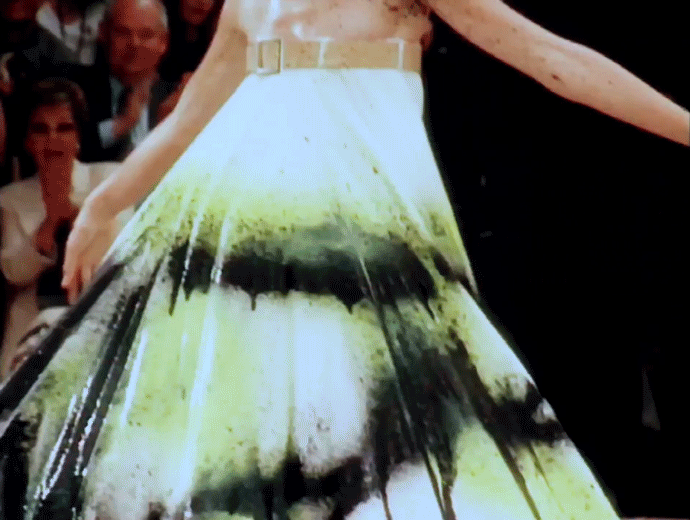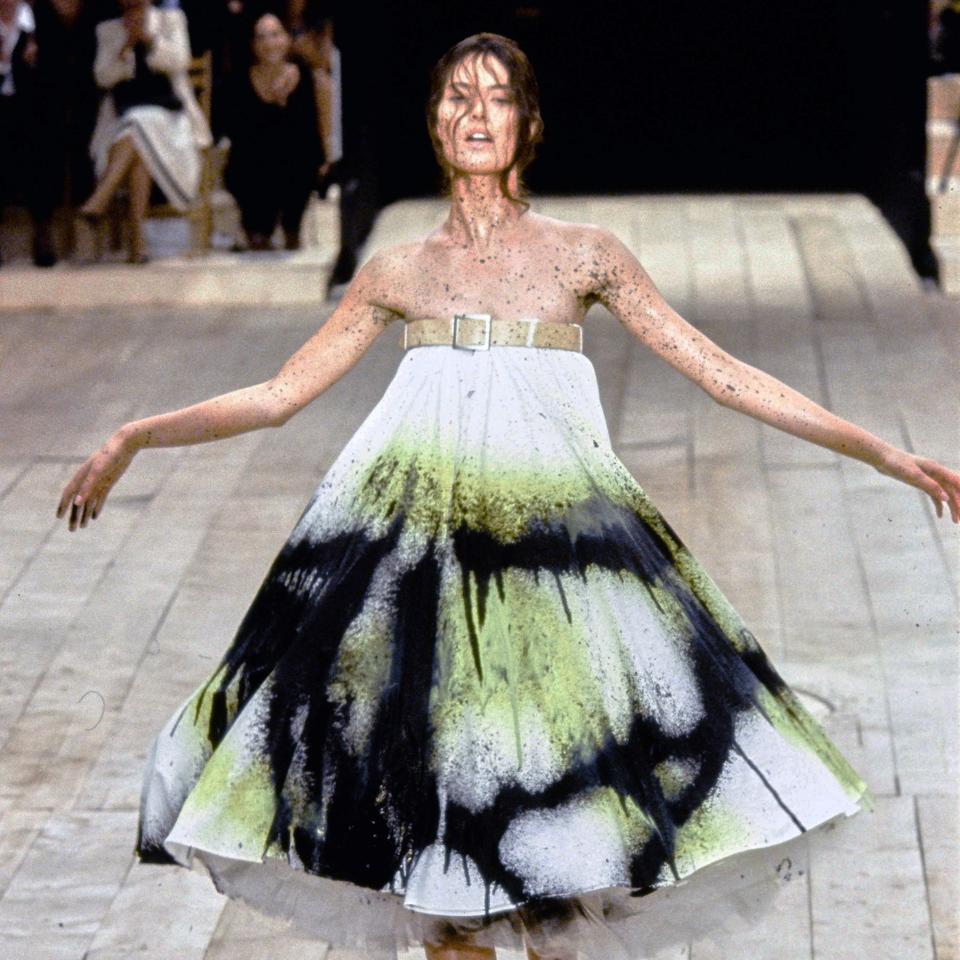Remembering the Potent Performance Art of Alexander McQueen’s Collection No. 13—20 Years Later
On September 28, 1998, I put on my black Helmut Lang trouser suit and emerald green suede New Balance trainers, ready to fight my way into a warehouse used for storing street cleaning trucks: It was the non-fragrant venue where Alexander McQueen was having his Spring 1999 show. Truthfully, I’ve no memory of what I was wearing that day—though Helmut Lang was my late ’90s uniform—but the evidence is there in the background of an archive photograph on Vogue Runway. There am I, sitting next to Hamish Bowles (in a Jasper Conran teal green Donegal tweed jacket, he tells me), as we calmly appreciate Shalom Harlow before us. She’s wearing one of McQueen’s modernized cutaway frock coats—nothing underneath—and a pair of his signature bumsters, which barely graze her lower hips. Little did we guess that we had ten minutes to go until we’d be jolted half out of our skins by the sight of Harlow—on again, in a white paper multi-layered dress—under sudden violent attack from a pair of car paint-spraying robots.
That’s something no one will forget. It’s a McQueen performance, a coup de théâtre that has made ever-living history, surely up there amongst the top 10 fashion show thrills of all time. No matter how many times you play it on video, the rawness and shock of it never diminishes: Harlow standing on a wooden turntable, flailing her beautiful arms above her head, protecting herself as the programmed machinery goes in, gunning at her with black and neon yellow paint. Around and around, woman against machine. It’s poignant, but it’s sexual too. Harlow was a ballet dancer, you see it in her. “She did exactly what she wanted to do,” says Sam Gainsbury, who produced the show with her partner Anna Whiting. “We couldn’t rehearse it. She knew how to keep her center on the turntable because she was a dancer. She didn’t flinch when they came near her face. It was completely spontaneous.”
She was mythic: a modern Leda and the Swan. In the pictures, everyone is leaning forward, hands clutching faces. Isabella Blow is there, McQueen’s mother Joyce, Philip Treacy, his closest people, as swept up as everyone else in watching Shalom’s virginal dress becoming a piece of graffiti action art. In these new days, when “experiential” and “immersive” are the current aspirations of all fashion houses, brands, and designers—the drive to make us feel something—looking again at what McQueen did in the ’90s is still heart-stoppingly inspirational.

What I actually remember was how he’d lulled us along into a false sense of tranquility. It was a long collection, with many successive passages of elegant tailoring and ruffled, romantic lace. This in itself should have been a red flag. McQueen, serene? You were always braced for something to happen—after all, the season before at that same venue, he’d had the runway burst into a terrifying circle of fire, with a hooded girl in a dripping red dress standing in its center, the denouement of his Joan of Arc show. This one went on so long that I had actually begun to ignore the installation of two dormant pieces of machinery. There was more than enough time to prove his mastery of technique and desirable, wearable clothes. I must have been scribbling something like, “He’s grown up. Lots of amazing tailoring.” Then the robots came alive.
“Lee wrote precise instructions to the factory about how he wanted the machines to move, joint by joint, like spitting cobras,” says Sam Gainsbury. “And it worked, exactly.” She’d gone to the car manufacturers to borrow the machinery. “What people don’t realize is that it wasn’t about spending gazillions. We all begged and made deals. Lee had a reputation at that point. We got the stadium seating installed free by saying the guys could bring friends and family. The wooden flooring was the cheapest there was. Everyone wanted to see what he was doing.”
At 30 years old, McQueen was still a young independent London designer with scarcely any budget to his name. That was no deterrent to all the biggest models who wanted to fly in to be part of his show. Shalom Harlow, Audrey Marnay, Erin O’Connor, Hannelore Knuts, Bridget Hall, and the not-yet-famous Gisele Bunchen all walked for £100 each. What I’d forgotten—or maybe only learned later—was that the show had opened with Aimee Mullins, the amputee Paralympic athlete, model, and actress, walking on the elaborately wooden legs McQueen had had carved for her. Many people mistook them for boots, and stylists asked to borrow them for shoots after. He didn’t mind that, he said later; he’d wanted to make her equal in beauty to all the others. In that, as in so much else, he was a pioneer.
Nature versus the machine, fear, and sensation were lifelong themes of McQueen’s. Along with Hussein Chalayan and John Galliano, he established a fearless experimental way of creating happenings which took fashion beyond mere displays of clothing and into the realms of the unforgettable, emotional experience. Quite beyond the current nostalgia for the styles of the ’90s, it all seems so relevant—prescient, even—to our craving for meaning in this digital age.

Read More Runway Stories:
Goodbye, Mom Jeans! This Is the New Denim Trend of 2018—Read More
Phil Oh’s Best Street Style Photos From the Fall ’18 Paris Haute Couture Shows—Read More
Christian Dior Fall 2018 Couture Collection—Read More
Valentino Fall 2018 Couture Collection—Read More
Chanel Fall 2018 Couture Paris Collection—Read More


